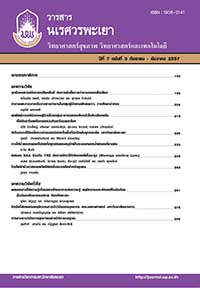ท่าทางและการบาดเจ็บจากการทำงานในกลุ่มผู้จักสานผักตบชวา: การศึกษานำร่อง
Keywords:
ท่าทางการทำงาน, การบาดเจ็บจากการทำงาน, การยศาสตร์, การจักสานผักตบชวา, Working posture, work-related injury, ergonomics, hyacinth weavingAbstract
การศึกษานี้มีวัตถุประสงค์เพื่อประเมินท่าทางการทำงานและการบาดเจ็บจากการทำงานในกลุ่มผู้จักสานผักตบชวา ตำบลสันป่าม่วง อำเภอเมือง จังหวัดพะเยา อาสาสมัครจำนวน 10 คน ได้รับการบันทึกภาพเคลื่อนไหวขณะจักสานด้วยกล้องดิจิตอล และได้รับบันทึกข้อมูลการบาดเจ็บจากการทำงานด้วยแบบประเมิน Standard Nordic Questionnaires ฉบับภาษาไทย ซึ่งท่าทางการทำงานของอาสาสมัครจะถูกประเมินด้วยแบบประเมิน Rapid upper limb assessment (RULA) ผลการศึกษาพบว่า ระดับคะแนนสุดท้ายจากการประเมินด้วยแบบประเมิน RULA ของอาสาสมัครทั้งหมดอยู่ในระดับ 2 (3-4 คะแนน) หมายถึงท่าทางการทำงานของอาสาสมัครควรจะได้รับการตรวจสอบต่อไปและอาจต้องแก้ไข นอกจากนี้ ข้อมูลการบาดเจ็บจากการทำงานพบว่าอาสาสมัครส่วนใหญ่มีอาการปวดหลังส่วนล่าง เมื่อวิเคราะห์ท่าทางการทำงาน พบว่า อาสาสมัครส่วนใหญ่มีการยกและงอแขนส่วนบนและส่วนล่างอยู่ในช่วง 20-45 และ 60-100 องศา ตามลำดับ และมีการก้มลำตัวและคออยู่ในช่วง 10-20 องศา ซึ่งท่าทางดังกล่าวถือเป็นท่าทางที่ไม่เหมาะสมและยังเพิ่มความเสี่ยงต่อการเกิดการบาดเจ็บจากการทำงานอีกด้วย ดังนั้น เพื่อเป็นการประเมินปัจจัยทางการยศาสตร์อย่างสมบูรณ์ ปัจจัยทางการยศาสตร์ด้านอื่นๆ ควรได้รับการตรวจสอบและติดตาม และการออกแบบสถานที่ทำงานใหม่สำหรับกลุ่มผู้จักสานผักตบชวาอาจมีความจำเป็น
Posture and work-related injury in hyacinth weaving group: A pilot study
Arunee Promsri1*
1 Department of Physical Therapy, School of Allied Health Sciences, University of Phayao, Amphur Muang, Phayao 56000
The purpose of this study was to assess working posture and work-related injury in the hyacinth weaving group of Tambon Sanpamuang, Amphur Muang, Phayao Province. Ten volunteers were recorded their work motions during weaving by digital cameras, and were recording their work-related injury by the Standard Nordic Questionnaires (Thai version). Work motions were evaluated by the Rapid Upper Limb Assessment (RULA). The results showed that the final score of RULA of all volunteers were at level 2 (score 3-4 points) referring to their working posture which should be investigated further. Moreover, the information about work-related injury demonstrated that most of the volunteers had the lower back pain. Deep analysis of working postures showed that most of the volunteers elevated and flexed their upper and lower arms in the range of 20-45 and 60-100 degree, respectively, and bent their trunks and necks in the range of 10-20 degree. These postures were the awkward posture, and closely increased risk of the work-related injury. These results indicated that the hyacinth weaving group should improve to improve their working postures. Therefore, for completing evaluation of ergonomic factors, the other factors of the ergonomics should be evaluated and followed-up, and the new design workplace for the hyacinth weaving group may be needed.
Downloads
Published
How to Cite
Issue
Section
License
ผู้นิพนธ์ต้องรับผิดชอบข้อความในบทนิพนธ์ของตน มหาวิทยาลัยพะเยาไม่จำเป็นต้องเห็นด้วยกับบทความที่ตีพิมพ์เสมอไป ผู้สนใจสามารถคัดลอก และนำไปใช้ได้ แต่จะต้องขออนุมัติเจ้าของ และได้รับการอนุมัติเป็นลายลักษณ์อักษรก่อน พร้อมกับมีการอ้างอิงและกล่าวคำขอบคุณให้ถูกต้องด้วย
The authors are themselves responsible for their contents. Signed articles may not always reflect the opinion of University of Phayao. The articles can be reproduced and reprinted, provided that permission is given by the authors and acknowledgement must be given.








